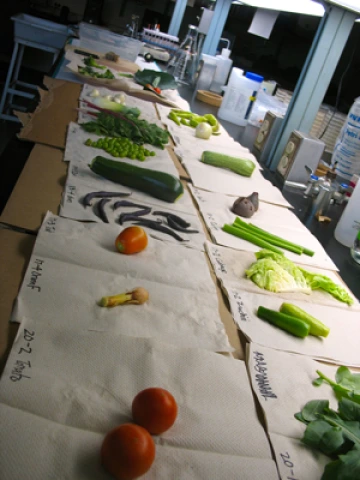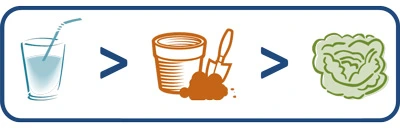Vegetable results

The results of this study showed that in general, arsenic concentrations were higher in Gardenroots vegetables than store-bought vegetables, as compared with the 2010 US Food and Drug Administration (FDA) Market Basket nationwide study.
Twenty different types of vegetables falling into 9 different plant families were grown in the greenhouse and/or Dewey-Humboldt gardens. (For vegetables with an asterisk (*), only one sample of that vegetable was received.)
- Lettuce, beans, onions, radishes, Brussels sprouts*, broccoli*, cabbage, beets, spinach*, peppers, carrot* celery* and corn* generally had higher arsenic concentrations that the US FDA study.
- Squash, cucumber*, and tomatoes generally had lower arsenic concentrations that the US FDA study.
- Kale, swiss chard, amaranth, and garlic were grown by community members, but these vegetables were not tested in the US FDA study, and so cannot be compared.
A major finding of the Gardenroots project is that, when combining greenhouse and home garden data, Asteraceae (lettuce) and Brassicaceae (radish, broccoli, brussels sprouts, kale, and cabbage) families were the top accumulators of arsenic. This finding has been reported in other studies.
The Big Picture
Overall, the Gardenroots project showed that homegrown vegetables did take up arsenic.

However, calculations of estimated average arsenic daily dose from the three potential exposure routes measured suggested that arsenic exposure was greatest from drinking water (when assuming the primary source of water for irrigation is also used for drinking), followed by incidental soil ingestion, with a relatively small contribution from homegrown vegetable ingestion. Thus, it is strongly recommended for Dewey-Humboldt community members to test drinking water yearly and to test soils prior to gardening. To be precautious and prudent, gardeners can modify gardening behavior to reduce incidental soil ingestion and limit the use of vegetables from the Asteraceae and Brassicaceae families. See "Recommendations/Resources" tab for more information.
Outcomes
Research: Gardenroots advanced our understanding of soils, uptake of arsenic by vegetables, exposure, and risk. A risk-based estimate of maximum soil arsenic concentration was developed for specific plant families to guide gardeners and farmers.
Individuals: Citizen-scientist participants increased their understanding of soil contamination, food quality, and the scientific process. Surveys showed that after learning their Gardenroots results, the majority of participants will continue to garden, but will change their gardening practices (i.e. following the recommended best practices for gardening handouts).
Community: A community-academic partnership was developed and community capacity was increased, resulting in community networking and participation in resource-related issues. For example, following elevated arsenic results for some participants on municipal water, community members worked together to notify authorities and bring attention to the problem, which is now in the process of being resolved.
For Further details about Gardenroots results, please refer to the following:
View the overview of study results.
For additional details, please refer to Dr. Ramírez-Andreotta’s publications:
- A greenhouse and field-based study to determine the accumulation of arsenic in common homegrown vegetables grown in mining-affected soils. Sci Total Environ. 2013 Jan 15;443:299-306. Download the PDF
- Home gardening near a mining site in an arsenic-endemic region of Arizona: Assessing arsenic exposure dose and risk via ingestion of home garden vegetables, soils, and water. Sci Total Environ. 2013 June 1;454-455:373–382. Download the PDF
- Building a co-created citizen science program with gardeners neighboring a Superfund site: The Gardenroots case study. In: Public Health: Improving Health via Inter-Professional Collaborations, NY: Nova Science Publishers, Eds: Caron RM and Merrick J. 2014. Download the PDF

